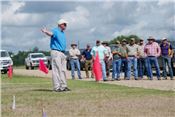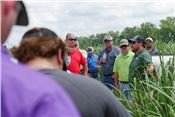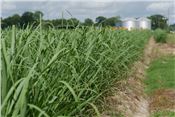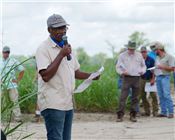As Louisiana Sugarcane Belt Grows, So Does AgCenter Research, Outreach
OLIVIA MCCLURE
MORGANZA, LOUISIANA
As Louisiana’s sugarcane acreage expands, farmers and scientists are learning more about how the crop performs outside of its traditional growing area.
They’re particularly interested in finding varieties that do well under the unique environmental conditions of the sugarcane belt’s northern and western fringes, where winters are colder and freeze damage to the tropical plant is a concern.
A recent field day at Joby Beaud’s farm in Pointe Coupee Parish highlighted researchers’ quest for new varieties that meet the industry’s evolving needs – from cold tolerance to improved yields and other desirable traits.
The location of the event was significant. Pointe Coupee is home to about 70,000 of Louisiana’s 490,000 acres of sugarcane, making it the state’s top-producing parish.
But it wasn’t always this way. Sugarcane acreage in the parish was estimated to be just 25,800 in 2000. It has more than doubled since then as row crop farmers seeking steadier yields and prices switched acres to sugarcane. Today, Pointe Coupee is one of the state’s northernmost cane-growing parishes.
Beaud’s farm near Morganza serves as a test location for varieties, which in Louisiana are developed and released through a cooperative effort of the LSU AgCenter, the U.S. Department of Agriculture and the American Sugar Cane League. Experts from each organization were on the field day program.
The event gave producers – some of whom have only recently gotten into the sugarcane business – a chance to see several varieties and hear about their benefits and drawbacks.
“It’s important that they see these new varieties that are coming out,” said AgCenter agent Mark Carriere, who organized the event.
“L 01-299 is the variety that everybody seems to have; it’s the workhorse. But our farmers have realized you can’t put all your eggs in one basket.”
Though cold tolerance is increasingly valued among Louisiana sugarcane farmers, no one gene is responsible for imparting this trait. Many minor traits add up to make plants cold hardy, and these can be influenced by both genetics and the environment in which plants are grown, said AgCenter sugarcane specialist Kenneth Gravois.
For example, cane with an erect growth habit – like the popular L01-299 variety – often can withstand freezes better than varieties that are more prone to blowing over. If strong winds have laid cane on the ground and then freezing temperatures set in, those plants will likely sustain more damage because cold air sinks, Gravois said.
Environmental factors matter, too.
“There’s nothing that will get the stomach acid churning more than a forecast for a freeze in November,” Gravois said. That’s because plants are still actively growing in November.
Freezes that come as harvest is wrapping up in December or January are still a cause for concern but tend to have lesser effects. The cane is more mature and has already been conditioned to cooler weather through the fall. And with the end of the processing season near, “it is a race to the end when a freeze strikes,” Gravois said.
Breeders face challenges in finding cold-tolerant varieties because Louisiana doesn’t experience hard or lengthy freezes every winter.
That limits how much data they can collect. But the test plots at Beaud’s farm as well as fields in Cheneyville in southern Rapides Parish provide opportunities to gather information when cold weather does strike.
AgCenter sugarcane breeder Collins Kimbeng explained the 12-year journey it takes to develop and release a new variety. Using different combinations of existing varieties, which act as parents, breeders begin the process with thousands of unique crosses. Each plant holds the potential to become a commercially released variety – but most never make the cut.
Decisions about which plants to advance to progressively more rigorous rounds of lab and field testing are made carefully, Kimbeng said. He likened the process to selecting athletes to send to the Olympics.
Technology helps scientists make these decisions, providing them useful data on characteristics such as sucrose content.
But “at the end of the day, it’s not all a numbers game,” Kimbeng said, noting the importance of field trials such as those at the AgCenter Sugar Research Station and the farms of partners such as Beaud. Visual observation of how plants perform in certain environments is another key element of the breeding process.
The variety development initiative, along with other research and extension programs at the AgCenter, is critical to the Louisiana sugarcane industry’s success.
“We’re the unicorn of the sugarcane industry,” said AgCenter weed scientist Al Orgeron, describing how Louisiana’s climate creates complications not seen in other countries. “We have to do so many things to remain competitive globally.”
Sugarcane breeding in Louisiana dates back to 1885, and since then, the AgCenter sugar station has been involved in developing more than 80 varieties. New varieties have allowed sugar yields to double in the past 50 years and extended the crop cycle, enabling farmers to grow multiple crops from a single planting, Gravois said.
As new needs have emerged over time, so have new varieties.
“We’ve always worked to solve our problems through breeding,” Gravois said. “That’s what is giving us the confidence to push northward.” ∆
OLIVIA MCCLURE: LSU AgCenter

LSU AgCenter weed scientist Al Orgeron speaks to attendees of a field day held May 31, 2022, at Joby Beaud’s sugarcane farm near Morganza.
Photos by Olivia McClure/LSU AgCenter

American Sugar Cane League agronomist Atticus Finger, right, speaks during a field day held May 31, 2022, at Joby Beaud’s farm near Morganza.

Sugarcane at Joby Beaud’s farm near Morganza.

LSU AgCenter sugarcane breeder Collins Kimbeng speaks at a field day held May 31, 2022, at Joby Beaud’s farm near Morganza.